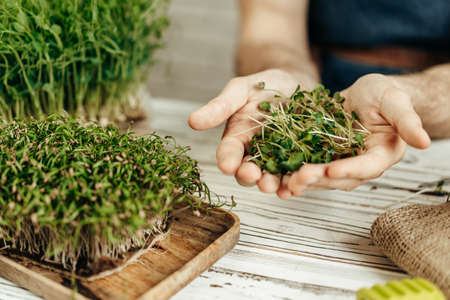1. Choosing the Right Herbs for Your Indoor Garden
Starting an indoor herb garden is a great way to have fresh, flavorful ingredients at your fingertips year-round. Whether youre cooking up your favorite pasta sauce or brewing a soothing tea, the right herbs can make all the difference. But not all herbs grow well indoors, so its important to choose ones that thrive in containers and lower-light conditions typically found inside homes.
Top Culinary Herbs for Indoors
These herbs are popular in American kitchens and do well indoors with proper care:
| Herb | Flavor Profile | Common Uses | Light Requirements |
|---|---|---|---|
| Basil | Sweet, peppery | Pasta, pesto, salads | Bright, direct sunlight |
| Parsley | Mild, slightly peppery | Garnishes, soups, sauces | Moderate to bright light |
| Chives | Mild onion-like taste | Egg dishes, dips, potatoes | Bright indirect light |
| Cilantro | Citrusy, slightly spicy | Salsas, tacos, curries | Bright but not too hot light |
Medicinal and Aromatic Herbs That Thrive Indoors
If youre looking to grow herbs for their calming scents or health benefits, here are some top choices:
| Herb | Benefits/Uses | Aroma | Light Requirements |
|---|---|---|---|
| Mint | Aids digestion, refreshing teas | Cool, crisp scent | Bright indirect light |
| Thyme | Antibacterial, culinary uses too | Earthy and strong aroma | Full sun or grow lights |
| Lemon Balm | Reduces stress and anxiety | Lemony and fresh scent | Bright light or partial sun |
Tips for Picking the Best Herbs for Your Space
- Light availability: Choose herbs based on how much natural light your space gets. South-facing windows work best.
- Your cooking habits: Grow what you use most often in the kitchen.
- Pots and spacing: Make sure each herb has its own pot with drainage holes to prevent root rot.
- Growth habits: Some herbs like mint can spread quickly—its best to keep them in separate containers.
Selecting the right herbs is the first step toward a thriving indoor garden that’s both beautiful and useful. Once youve chosen your favorites, it’s time to get planting!
2. Selecting the Best Containers and Soil
Choosing the right containers and soil is key to growing healthy, thriving herbs indoors. Your herbs need proper drainage, enough room for root development, and nutrient-rich soil to flourish. Let’s break down what you should look for when selecting pots and potting mixes.
Choosing the Right Containers
When it comes to containers, not all pots are created equal. Look for ones that offer good drainage—this helps prevent root rot caused by excess moisture. Also, consider the size of your container based on the type of herb youre planting.
Container Features to Consider:
| Feature | Why It Matters |
|---|---|
| Drainage Holes | Prevents water from accumulating at the bottom and causing root rot. |
| Material (Clay, Ceramic, Plastic) | Clay is breathable but dries faster; plastic retains moisture longer. Choose based on your watering habits. |
| Size | A minimum of 6–8 inches in diameter is ideal for most herbs. |
| Saucers or Trays | Helps catch excess water and protects your indoor surfaces. |
Selecting the Ideal Potting Soil
Herbs thrive in well-draining, nutrient-rich soil. Avoid using garden soil indoors—it’s too dense and may contain pests. Instead, opt for a high-quality potting mix designed for container gardening.
What to Look for in Potting Mix:
- Lightweight and Well-Draining: A mix that includes ingredients like perlite, vermiculite, or coconut coir allows air to reach roots while draining excess water.
- Nutrient-Rich: Look for soil that contains compost or slow-release organic fertilizers to feed your herbs over time.
- No Added Chemicals: Especially important if you plan to eat your herbs—choose organic mixes whenever possible.
DIY Potting Mix Recipe (Optional):
If you want to make your own herb-friendly soil mix, here’s a simple recipe:
| Ingredient | Purpose | Ratio |
|---|---|---|
| Coconut Coir or Peat Moss | Retains moisture while staying light | 2 parts |
| Perlite or Vermiculite | Improves drainage and aeration | 1 part |
| Compost or Worm Castings | Adds nutrients naturally | 1 part |
Selecting the right containers and soil gives your indoor herb garden a strong foundation. With good drainage and nutrient-rich support, your herbs will be set up to grow vibrant and flavorful all year round.
![]()
3. Finding the Perfect Spot in Your Home
Choosing the right location for your indoor herb garden is one of the most important steps to ensure healthy, thriving plants. Most herbs love sunlight, so picking a spot that gets plenty of natural light throughout the day is key.
Let There Be Light!
Herbs like basil, thyme, rosemary, and parsley need at least 6 hours of sunlight each day. South-facing windows are ideal because they typically receive the most consistent and direct light. If you don’t have a south-facing window, east or west-facing ones can also work well.
Best Indoor Spots for Herbs
Here are some great indoor spaces where your herbs can thrive:
| Location | Pros | Things to Watch Out For |
|---|---|---|
| Windowsill | Gets good natural light; easy access for watering and harvesting | Watch out for drafts or extreme temperature changes |
| Kitchen Counter (near a window) | Convenient while cooking; usually warm and bright | Avoid placing too close to stove heat or splash zones |
| Sunroom or Enclosed Porch | Tons of sunlight; often warmer environments | Might get too hot in summer—monitor soil moisture levels closely |
| Shelf with Grow Light | Perfect for rooms without enough natural light; year-round growing | Requires electricity and initial setup cost for grow lights |
Tips for Maximizing Light Exposure Indoors
- Rotate your pots regularly: This ensures even growth as all sides of the plant get sunlight.
- Keep windows clean: Dust and dirt can block sunlight from reaching your herbs.
- Use reflective surfaces: Placing herbs near white walls or using mirrors can help bounce more light onto them.
- Add grow lights if needed: Especially helpful during winter months when daylight is limited.
A Note on Temperature and Air Flow
Your herbs will do best in temperatures between 65°F and 75°F. Avoid spots that are too cold (like near drafty windows in winter) or too hot (like directly above heating vents). Good air circulation also helps prevent mold and pests, so give your plants some breathing room by not crowding them together too tightly.
With a little planning, you can find a cozy, sunny spot in your home where your herbs will be happy to grow year-round.
4. Watering, Feeding, and General Care Tips
Taking care of your indoor herb garden doesn’t have to be complicated. With the right routine, your herbs will thrive year-round. Here’s how to water, feed, and keep your plants healthy.
How Often Should You Water Indoor Herbs?
The frequency of watering depends on the type of herb, the container size, and your indoor environment. Most herbs like their soil to be slightly moist but not soggy. Overwatering is one of the most common mistakes for beginners.
| Herb | Watering Frequency | Soil Preference |
|---|---|---|
| Basil | Every 2–3 days | Moist, well-drained |
| Mint | Every 2–3 days | Damp, but not soaked |
| Rosemary | Once a week | Drier soil, well-drained |
| Thyme | Once every 5–7 days | Slightly dry between watering |
| Cilantro | Every 2–4 days | Consistently moist |
A good rule of thumb is to stick your finger about an inch into the soil—if it feels dry at that depth, it’s time to water.
Fertilizing Your Herbs
Your indoor herbs don’t need a ton of fertilizer, but a little boost now and then helps them grow strong and flavorful. Use an all-purpose liquid fertilizer diluted to half strength about once a month during the growing season (spring through early fall).
Best Practices for Fertilizing:
- Avoid fertilizing newly planted herbs for the first 3–4 weeks.
- If leaves start turning yellow or growth slows down, it may be time to feed.
- Avoid over-fertilizing—too much can reduce flavor intensity.
Pest Prevention and Mold Control
Pests like aphids and fungus gnats can sometimes show up indoors, especially in warm or humid conditions. Mold can also form if there’s poor air circulation or excess moisture. Here’s how to stay ahead of these issues:
Pest Control Tips:
- Inspect leaves regularly for signs of pests (sticky residue, tiny bugs, holes).
- If you spot pests, spray with a natural insecticidal soap or neem oil.
- Avoid bringing in outdoor plants that may carry pests.
Mold Prevention Tips:
- Avoid overwatering and ensure pots have proper drainage.
- Add a small fan nearby to improve air circulation if needed.
- Avoid letting water sit on leaves or soil surface for too long.
Caring for your indoor herb garden becomes second nature with just a little attention each week. Keep an eye on moisture levels, feed sparingly, and watch out for pests—and your kitchen will always have fresh herbs within reach!
5. Harvesting and Using Your Fresh Herbs
One of the most rewarding parts of growing an indoor herb garden is harvesting your fresh herbs and using them in your daily life. With the right techniques, you can enjoy a continuous supply while keeping your plants healthy and productive.
How to Harvest for Continuous Growth
Knowing when and how to harvest your herbs is key to encouraging new growth. Here are some basic tips:
| Herb | When to Harvest | How to Cut |
|---|---|---|
| Basil | When plant has at least 6 leaves per stem | Pinch off just above a leaf node (where two leaves meet the stem) |
| Mint | Before it flowers | Trim stems just above the first or second set of leaves |
| Parsley | When leaves are bright green and mature | Cut stems close to the base of the plant |
| Thyme | Just before flowering for best flavor | Snip sprigs from the top, leaving woody stems behind |
| Cilantro | When plant is about 6 inches tall | Cut outer leaves first, near the soil line |
Creative Ways to Use Fresh Herbs at Home
Your freshly harvested herbs aren’t just for cooking—they can be used in a variety of creative ways around your home. Here are some ideas:
Culinary Uses
- Basil: Blend into pesto, sprinkle over pizza, or add to caprese salad.
- Cilantro: Mix into salsa, tacos, or fresh guacamole.
- Parsley: Chop into tabbouleh or use as garnish for soups and meats.
- Thyme: Add to roasted veggies or stews for earthy flavor.
- Mint: Brew into tea or muddle into a refreshing mojito.
Lifestyle Uses
- Aromatic Sachets: Dry lavender or mint and place in small fabric bags for drawers or closets.
- Dried Herb Bundles: Tie together rosemary, sage, and thyme for natural home fragrance.
- Spa Treatments: Add crushed mint or rosemary to homemade scrubs or bath soaks.
- Decorative Garnishes: Use sprigs of fresh herbs to dress up cocktails or dinner plates.
Tips for Storing Extra Herbs
If you have more herbs than you can use right away, consider these easy storage methods:
| Method | Description |
|---|---|
| Drying | Tie herbs in bundles and hang upside down in a cool, dry place. |
| Freezing | Chop herbs and freeze in ice cube trays with water or olive oil. |
| Pesto Cubes | Create herb-based pestos and freeze in small portions for later use. |
The more you harvest and use your herbs, the more they’ll thrive. Whether youre adding a pop of flavor to dinner or creating DIY gifts, your indoor herb garden offers endless possibilities right at your fingertips.


